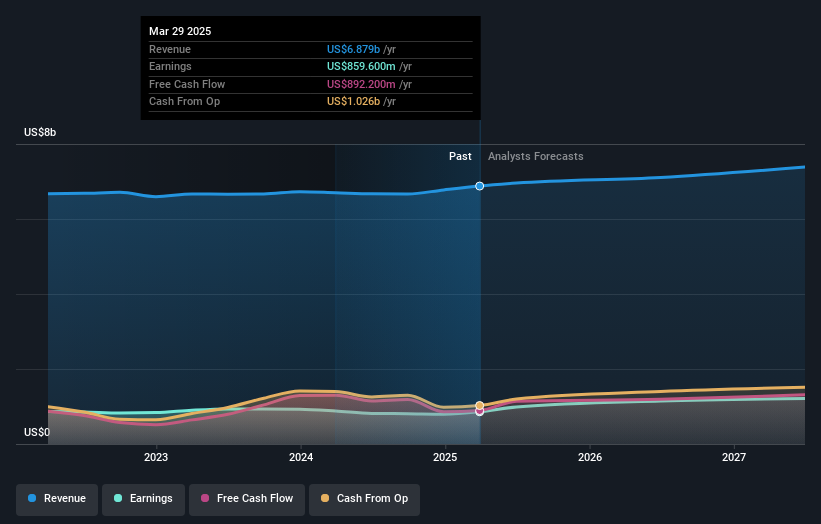
Tapestry, Inc. (NYSE:TPR) just released its latest third-quarter results and things are looking bullish. The company beat expectations with revenues of US$1.6b arriving 3.7% ahead of forecasts. Statutory earnings per share (EPS) were US$0.95, 7.4% ahead of estimates. This is an important time for investors, as they can track a company's performance in its report, look at what experts are forecasting for next year, and see if there has been any change to expectations for the business. With this in mind, we've gathered the latest statutory forecasts to see what the analysts are expecting for next year.

Taking into account the latest results, the most recent consensus for Tapestry from 18 analysts is for revenues of US$7.11b in 2026. If met, it would imply a satisfactory 3.3% increase on its revenue over the past 12 months. Per-share earnings are expected to soar 31% to US$5.41. In the lead-up to this report, the analysts had been modelling revenues of US$7.07b and earnings per share (EPS) of US$5.44 in 2026. So it's pretty clear that, although the analysts have updated their estimates, there's been no major change in expectations for the business following the latest results.
Check out our latest analysis for Tapestry
The consensus price target rose 5.9% to US$88.79despite there being no meaningful change to earnings estimates. It could be that the analystsare reflecting the predictability of Tapestry's earnings by assigning a price premium. That's not the only conclusion we can draw from this data however, as some investors also like to consider the spread in estimates when evaluating analyst price targets. There are some variant perceptions on Tapestry, with the most bullish analyst valuing it at US$110 and the most bearish at US$62.00 per share. These price targets show that analysts do have some differing views on the business, but the estimates do not vary enough to suggest to us that some are betting on wild success or utter failure.
Looking at the bigger picture now, one of the ways we can make sense of these forecasts is to see how they measure up against both past performance and industry growth estimates. It's pretty clear that there is an expectation that Tapestry's revenue growth will slow down substantially, with revenues to the end of 2026 expected to display 2.7% growth on an annualised basis. This is compared to a historical growth rate of 6.3% over the past five years. Compare this against other companies (with analyst forecasts) in the industry, which are in aggregate expected to see revenue growth of 5.4% annually. Factoring in the forecast slowdown in growth, it seems obvious that Tapestry is also expected to grow slower than other industry participants.
The Bottom Line
The most obvious conclusion is that there's been no major change in the business' prospects in recent times, with the analysts holding their earnings forecasts steady, in line with previous estimates. Fortunately, the analysts also reconfirmed their revenue estimates, suggesting that it's tracking in line with expectations. Although our data does suggest that Tapestry's revenue is expected to perform worse than the wider industry. There was also a nice increase in the price target, with the analysts clearly feeling that the intrinsic value of the business is improving.
Keeping that in mind, we still think that the longer term trajectory of the business is much more important for investors to consider. We have estimates - from multiple Tapestry analysts - going out to 2027, and you can see them free on our platform here.
Before you take the next step you should know about the 3 warning signs for Tapestry that we have uncovered.
Have feedback on this article? Concerned about the content? Get in touch with us directly. Alternatively, email editorial-team (at) simplywallst.com.
This article by Simply Wall St is general in nature. We provide commentary based on historical data and analyst forecasts only using an unbiased methodology and our articles are not intended to be financial advice. It does not constitute a recommendation to buy or sell any stock, and does not take account of your objectives, or your financial situation. We aim to bring you long-term focused analysis driven by fundamental data. Note that our analysis may not factor in the latest price-sensitive company announcements or qualitative material. Simply Wall St has no position in any stocks mentioned.